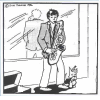Sunday, September 11, 2005
The Mostly True Story of Matthew and Trim
 by Cassandra Golds and Stephen Axelsen
by Cassandra Golds and Stephen AxelsenThis new children's graphic novel is a very welcome step by local (Australian) publishing!
Author Cassandra Golds retells the historic story of great seafaring explorer and cartographer Matthew Flinders and his travelling companion, Trim the cat. Stephen Axelsen illustrates in a comic format, using subdued colours and a relaxed style with lots of expression and enough detail to really bring the story to life.
To begin with Golds adheres to history, and the early episodes are tight and accurate, containing a lot of information, but interestingly told. Later in the story her imagination has full flight - oddly enough during the period of Flinders' imprisonment in French Mauritius - and the story really takes off. The episodic nature of the telling (I'm assuming this was originally created as a serial in a children's magazine) detracts a little, particularly in the early stages, but this diminishes as the chapters become longer and more easily connected.
Overall, there is a poignant, elegaic feel to the story, with many unfortunate or tragic turns. I particularly liked the care shown in telling us what happens with Anne, Flinder's wife, his friendship with Bass, and Trim's encounter with a dodo. There is much in the story that is downbeat, but the charm of both the telling and the illustrations make it consistently a journey worth taking.
The retrospective telling of the story by the ghosts of Matthew and Trim is a sometimes awkward device necessitated by the nature of the story, but does help connect the history to a current time and place, which is helpful for young readers. Axelsen's style is immediate and appealing, communicating a great deal of pathos, and his decision to letter in fountain-pen (using upper and lower case) both befits the context and makes it friendly for young readers.
Penguin Books (Puffin) are to be commended for taking the plunge into a comic-style format and producing a beautiful book suitable to sit alongside Asterix and Tintin in school library and personal collections alike.
More information (and sample pages) here.
(While I've written lots of reviews of Australian comics for OzComics Magazine and currently review for Inkspot, I don't usually review comics online, but this one seems significant and hopefully will be the beginning of a new trend among local publishers.)
Labels: Australian comics, Children's books
Comments:
Post a Comment
